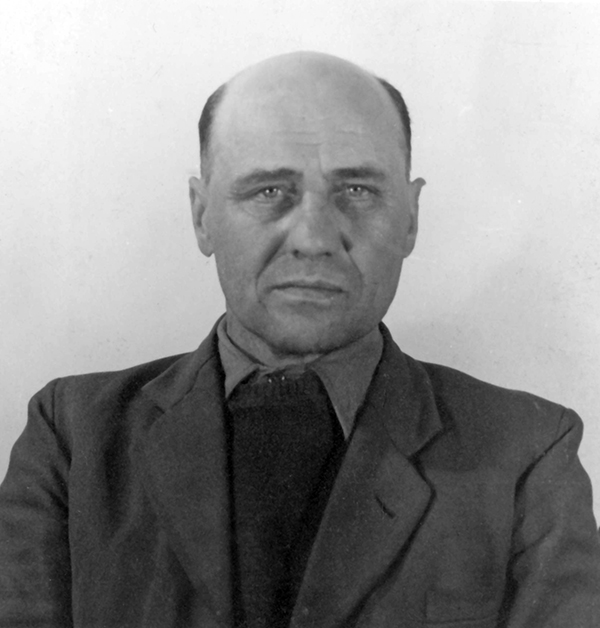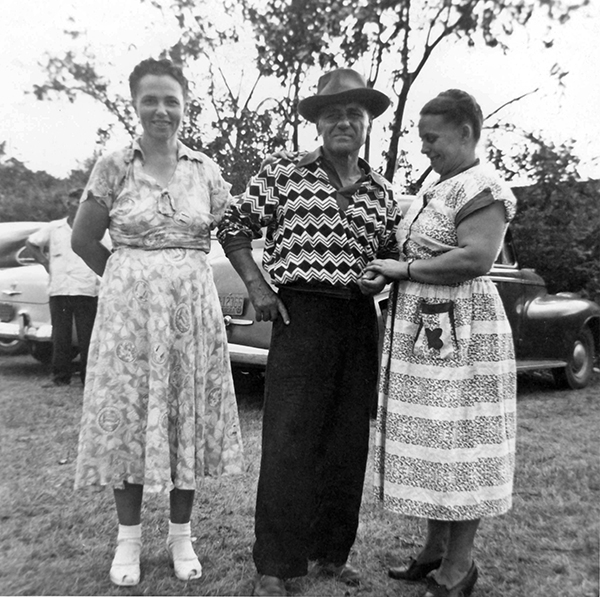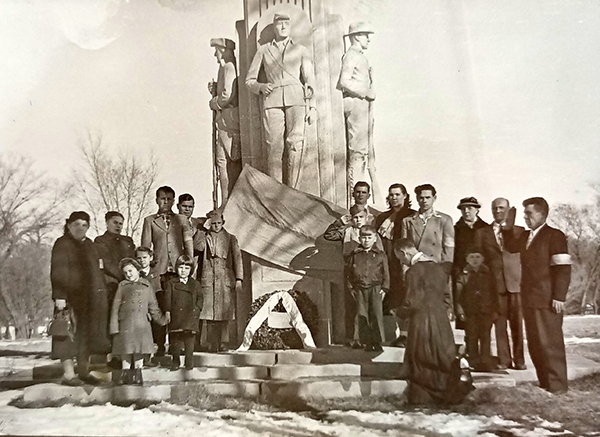This is the third of a three-part series. The entire article appears in the Fall 2023 issue of Nebraska History Magazine. You can receive four issues a year of Nebraska History Magazine with a Household-Plus membership. Learn more here.
By William Kelly
Jakob Drozdow: The Profile of a Displaced Person
The Church World Service emerged as one of the foremost resettlement agencies in the United States. The CWS forged partnerships with state-level governments and religious groups, such as the Nebraska Council of Churches, before pairing thousands of displaced persons with American sponsors. Through these programs, displaced families and individuals from countries like Lithuania, Croatia, Estonia, Poland, Ukraine, and Hungary navigated European refugee camps and, ultimately, relocated to urban landscapes such as South Omaha or Lincoln, or rural communities like Burchard, Nebraska. One such individual, Jakob Drozdow, followed this path. From witnessing Nazi occupation to harboring in refugee camps to commencing a new life chapter in Nebraska, Jakob Drozdow’s story illuminates some experiences displaced persons faced along their resettlement journey.
“Jakob Drozdow was born in Russia on 8th October 1894, of peasant parentage, and went to school for two years. He is of Russian nationality, and a member of the Orthodox Church. He speaks Russian and Ukrainian, and has promised to learn at least a working knowledge of English. He is a single man, and has no friends or relatives in the States… He was deported to Germany in 1944, as compulsory labour, and compelled to work on road construction and repair… He is clean and sober, and given the right placing, will give many years of true and loyal service. He is recommended for a position of trust.”[i]
Written in a narrative report in 1949, the quote above offers the best description of Jakob Drozdow that can be found in the archive. Correspondence, receipts, images, and ship manifests help create a more complete profile of a man who, like thousands of other non-combatants, had his life disrupted by World War II. Drozdow’s story is one example of the strategies and obstacles faced by displaced persons after the war, and offers a personal glimpse behind the statistics and data into the lives of displaced persons in Nebraska.
The historical record suggests that Jakob Drozdow lived in Smolensk before and during World War II. Smolensk, a historically embattled city, is a Russian outpost 260 miles west of Moscow.[ii] Drozdow would have witnessed through some of the heaviest fighting World War II when war encroached upon Smolensk by 1941. For more than two years, Drozdow lived through Nazi-Germany’s twenty-six-month occupation of the city beginning in September 1941. During that time, 90 percent of Smolensk was destroyed while 135,000 Russian soldiers and civilians perished. In September 1943, Drozdow became one of the 87,000 Russian men, women, and children deported from Smolensk to Germany where he was forced to work on road construction and repair until the end of the war.[iii]
Upon the liberation of Germany by Allied forces, Jakob Drozdow—along with thousands of other persons displaced by the war—faced a crucial decision. He could return home to a war-ravaged community and live under a violently repressive regime. Or he could relocate to a refugee camp in an occupied zone of Germany managed by Allied forces. Drozdow chose the latter option. Between the end of the war and 1951, Jakob Drozdow lived at refugee camps near in north-central Germany.[iv] There, Drozdow’s agricultural and beekeeping skills were tested and graded as “first class” by camp officials. His conduct was described Drozdow’s behavior as “exemplary” between September 1948 and November 1949. Work report cards show that Drozdow received wages for his labor in Oerrel, the same community that Drozdow identified as his place of residence when he filed for naturalization in the United States in the late 1950s.[v]
From refugee centers in north-central Germany, Drozdow sailed to the United States in the summer of 1951. A telegram informed the head of the Nebraska Council of Churches—one of the many state-level organizations helping to relocated displaced persons after World War II—Jakob Drozdow would be arriving in New York City on August 20.[vi] That week, Drozdow reached southeastern Nebraska and met his American sponsors for the first time: a brother and two sisters who operated a farm southwest of Burchard. Resettlement organizations likely paired Drozdow with this family because of Drozdow’s previous agricultural experience. But translating that experience across the Atlantic to Nebraska proved more difficult than might have been expected.[vii]
Soon after Jakob Drozdow began his resettled life at the Burchard farm, his sponsors voiced concerns to the resettlement agency. The aging Drozdow was struggling to adapt to agricultural work under the hot Nebraska sun. In a letter to the head to one of the main resettlement organizations in Nebraska, Reverend Carroll Lemon, Drozdow’s sponsors recounted their surprise when a nearly sixty-year-old man arrived on their farm to bale hay and raise cattle. Though his sponsors described Drozdow as “very neat [and] orderly,” they also noted that Drozdow spoke little English and seemed unfamiliar with certain farm equipment. The letter ended with a lingering sense of doubt. “We are busy putting up prairie hay and will give him as good a try out as it is humanly possible to give,” the sponsors wrote, “but under the circumstances you know it is a steep up hill [sic] climb. We ourselves all feel he might not be able to fit in our set up.”[viii]
One week later, Jakob Drozdow’s situation had not improved. Struggling to grapple with the Nebraska heat, and likely finding the cultural shift from Eastern Europe to the United States difficult, the duties of the Burchard farm became increasingly challenging. “This man seems to be a willing worker [and] is clean [and] orderly [and] cooperative, but he expresses no desire to learn any English,” Drozdow’s sponsors wrote to Reverend Lemon in August 1951. Gaining access to an interpreter to ease the language barrier was also out of the question in rural Nebraska. “There is no one within 15 or 20 miles could act as interpreter [and] with dirt roads it is almost impossible.”[ix] In need of a solution, Drozdow’s sponsors took him to the Nebraska State Fair in Lincoln in early September. It was there, they thought, that Drozdow might be exposed to the city and find a more suitable lifestyle.[x]
Jakob Drozdow eventually moved to Lincoln sometime after that trip to the Nebraska State Fair in 1951 and found work at John Supply and Coal Company in the city. Life in a larger community seems to have benefited Drozdow. He joined a local Orthodox Church where he likely met recent immigrants to the United States and, potentially, other displaced persons from Eastern Europe. Though he did not have any family nor friends in Nebraska when he moved to the state in 1951, photographs show that Jakob Drozdow was not alone after moving to Lincoln.
One photograph shows Drozdow with two female friends. Another set of images depicts an upright Drozdow standing proudly though solemnly with his community. In these two images, Drozdow and his comrades wear a band around their upper arms likely in remembrance of recent war that made Drozdow and thousands of others displaced persons.[xi]
Drozdow became ill in late 1958. Throughout 1959, he was in and out of the hospital and on certain medications, though the specifics of the illness are unclear. Jakob Drozdow died at age sixty-one on September 23, 1959. He was buried in a cemetery on the outskirts of northeast Lincoln. His obituary only briefly describes the major turning points in his life: where he lived, the church he belonged to, the year he moved from Russia to the United States, and where he was to be buried. It does not name any other individuals, family, or friends made while Drozdow lived in the United States. Johnson Supply and Coal company sent flowers, but a record of who attended his funeral does not survive.[xii]
However, none of this can be taken to assert that Jakob Drozdow was completely alone in Lincoln. Drozdow’s life as a displaced person in Nebraska apparently had two phases. The first was a difficult chapter of arduous farm labor under the hot Nebraska sun. A challenging assignment for anybody, but especially for an individual who had been living in the midst of World War II for nearly a decade. Language barriers, cultural isolation, and physical capabilities meant that Drozdow’s agricultural experience did not effectively translate to similar work in Burchard, Nebraska.
The second phase, illustrated by the photos, seems to show that Jakob Drozdow built a social network of friends and comrades after moving to Lincoln in 1951. He found a job and found a church. In the city, he likely met other displaced persons or recent immigrants to the United States. With them, he found support to either overcome or cope with the trauma of displacement by war and cultural transition. When he died in 1959, he left behind a small community of support. Although their names do not appear in any obituary or funeral guestbook, their presence is undeniable.[xiii]
Drozdow’s experiences as a displaced person after World War II sheds light on some of the challenges other refugees likely faced. He was not the only single male over the age of fifty displaced after the war. He was not the only European whose life was disrupted by Nazi occupation. And Drozdow was certainly not alone in the Hannover displaced persons camp, one of many around Germany. For many displaced persons, the end of World War II did not bring political stability or tolerance to their home regions. Drozdow’s hometown of Smolensk is only one example. As a result, thousands of displaced persons, like Drozdow, sought to begin a new life chapter outside of Europe. For Drozdow, that new chapter began in Nebraska. For others, it began in Minnesota, New York, Canada, Australia, or Israel. But no matter the final destination, the stories and migrations of displaced persons constitute an important dimension to post-war life in the United States and around the world.
About the author: William Kelly is a PhD candidate at the University of Nebraska-Lincoln’s Department of History. Kelly completed this project as a graduate research assistant at History Nebraska; the UNL history department provides an assistantship in which a doctoral student conducts research under the supervision of this magazine’s editor.
Notes:
[i] “Narrative Report: DROZDOW. Jakob,” NCRDP, Box 125, Folder 4.
[ii] The contested political boundaries of his Eastern European origins meant Drozdow’s nationality and birthplace were inconsistently recorded from refugee camps to United States immigration offices. Whether through lack of asking or because a language barrier, Drozdow’s birthplace proved elusive for recordkeepers. See NCRDP, Box 125, Folder 4; A certificate of good conduct written in 1949 by a commanding officer at a Displaced Persons Assembly Center (DPACS) ambiguously classified Drozdow’s nationality as Ukrainian/Russian. In the document, it is written “UKR./Russian.” “Certificate of good conduct,” Nov. 29, 1949, Unterluess, NCRDP, Box 125, Folder 4. When Drozdow filed for disability insurance at a displaced persons camp near Hannover, Germany, in 1951, the record notes that Drozdow was born on Oct. 8, 1894, in “Smolenska,” Ukraine. “Smolensk,” The Columbia Encyclopedia, by Paul Lagasse, and Columbia University. 8th ed. Columbia University Press, 2018; “Certificate Bescheinigung, E.C. No: 254389, 502 IRO Resettlement Centre Hamburg – Wentorf,” June 18, 1951, NCRDP, Box 125, Folder 4; Laurie R. Cohen, Smolensk under the Nazis: Everyday Life in Occupied Russia (Rochester, NY: University of Rochester Press, 2013), 8.
[iii] Cohen, Smolensk under the Nazis, 7; “Narrative Report: DROZDOW. Jakob”; “Macher & Preis,” Jan. 20, 1949, NCRDP, Box 125, Folder 4.
[iv] Drozdow may have lived in at least two different camps, one in Unterluess and another at Oerrel. Both refugee centers were within ten miles of each other in north-central Germany near Hanover. When Drozdow began the process of applying for U.S. naturalization in the late 1950s, his form indicates that he lived at “Orel” from September 1943 until he left for the United States in August 1951.
[v] “Arbeitsamt Uelzen,” NCRDP, Box 125, Folder 4.
[vi] “Western Union: KB146 SY A317,” Aug. 9, 1951, NCRDP, Box 125, Folder 4.
[vii] “Herman Peter Bachenberg,” Beatrice Daily Sun, Sept. 13, 1994, A-7; United States Federal Census, 1950, Plum Creek, Pawnee, Nebraska, Roll: 5806; Sheet Number: 4; Enumeration District: 67-11; “It is suggested that Mr. Drozdow be employed in the States as a caretaker, preferably in a farming district, as this has been his environment from birth. See “Narrative Report: DROZDOW. Jakob.”
[viii] Letter from Bachenberg to Carroll H. Lemon, Aug. 24, 1951, NCRDP, Box 125, Folder 4.
[ix] Letter from Bachenberg to Lemon, Aug. 31, 1951, NCRDP, Box 125, Folder 4.
[x] Advertisement, State Fair, 1951. 1951. Print, 11 in x 14 in., History Nebraska, 9778-10.
[xi] “Burman, Ellis,” History Nebraska, accessed July 11, 2022, https://history.nebraska.gov/publications/burman-ellis.
[xii] “Nebraska Council of Churches: 1958 – Oct-Nov Dec,” History Nebraska; Receipt, Providence Hospital, Jan. 3, 1959, NCRDP, Box 125, Folder 4; “Helmsdoerfer Funeral Home,” NCRDP, Box 125, Folder 4.
[xiii] In addition to the photographs, other individuals emerge as allies of Jakob Drozdow through correspondence and old checks. Reverend Carroll Lemon of the Nebraska Council of Churches and leader of displaced persons resettlement in Protestant circles served as executor of Drozdow’s estate until all his debts were paid off in 1960. In Lemon’s correspondence after Drozdow’s death, Conrad Supronovich, Puals Bechmanis, and Peter Lysenko are thanked by Lemon for their “kind spirit and personal interest as you served Mr. Drozdow and me.” It is certain that at least Lysenko was a former displaced person who originally resettled in Palmyra in July 1950. Lysenko lived in Omaha at the time of Drozdow’s death, See, “Estate of JACOB DROZDOW, Deceased,” NCRDP, Box 125, Folder 4; “Former Displaced Persons in Nebraska as of July 1, 1954,” NCRDP, Box 125, Folder 8.






